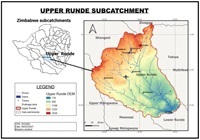Energy research in a pluralistic system: Bibliometric analysis of SA publications
Abstract
This article presents the results of a bibliometric analysis of South African energy publications during the period 2011 to 2021. Bibliometric analyses have the potential to reveal policy issues that cannot be identified easily through other approaches (e.g., peer review). Several findings are important for policy. It is identified that a substantial number of the energy publications produced by South Africans are proceedings papers. Identification of the main funders leads to the assumption that the National Research Foundation funding for conferences has led to the overproduction of proceedings. The most prolific producers of energy research produce approximately the same number of publications. Energy research is distributed to a large number of universities in the country. It is suggested that this may create diseconomies of scale. Comparisons of the organizational outputs of the South African organizations with international entities identify that the country’s organizations are subcritical. Analysis of the international collaborative patterns of energy identifies that collaboration is very light in comparison to collaborative patterns of all disciplines. It is noted that researchers moved towards renewable technologies even though there is no relevant support from the government. The investigation identifies that bibliometrics is a powerful approach for monitoring and evaluating disciplines within systems of innovation.
References
[1]Department of Science and Innovation. Draft Science, Technology, and Innovation Decadal Plan. Department of Science and Innovation, Pretoria; 2022.
[2]Department of Science and Innovation. Higher education, science, technology, and innovation institutional landscape (HESTIIL)—Review Report. Department of Science and Innovation, Pretoria; 2021.
[3]United Nations. Transforming our world: The 2030 agenda for sustainable development 2015. Available online: https://sustainabledevelopment.un.org/content/documents/21252030%20Agenda%20for%20Sustainable%20Development%20web.pdf (accessed on 11 September 2015).
[4]Department of Mineral Resources and Energy. Integrated Resource Plan 2023. Available online: https://www.dmre.gov.za/mining-minerals-energy-policy-development/integrated-resource-plan/irp-2023 (accessed on 11 September 2024).
[5]Pouris A. Towards a metric of organizational structures for S&T policy: The concept of science policy space. South African Journal of Science. 1995; 91: 489-492.
[6]Department of Health, Education and Welfare. Towards a Social Report. Department of Health, Education and Welfare University of Michigan Press, Ann Arbor; 1970.
[7]Academy of Science of South Africa. The state of energy research in South Africa. Academy of Science of South Africa, Pretoria; 2014.
[8]Pouris A. Structure of energy related literature: An application of citation analysis. South African Journal of Science. 1988; 83: 138–142.; doi/pdf/10.10520/AJA00382353_4679
[9]Pouris A. bibliometric assessment of energy research in South Africa. South African Journal of Science. 2016; 112(11/12): 8. doi: 10.17159/sajs.2016/20160054
[10]Dhamija P. South Africa in the era of Industry 4.0: An Insightful Investigation. Scientometrics. 2022; 127(9): 5083-5110. doi: 10.1007/s11192-022-04461-z
[11]Bambo TL, Pouris A. Bibliometric analysis of bioeconomy research in South Africa. Scientometrics. 2020; 125(1): 29-51. doi: 10.1007/s11192-020-03626-y
[12]Sooryamoorthy R. Scientific knowledge in South Africa: information trends, patterns and collaboration. Scientometrics. 2019; 119(3): 1365-1386. doi: 10.1007/s11192-019-03096-x
[13]Chinnasamy B, Yuvakkumar R, Kumar PS, et al. Mapping and Scientometric Measures on Research Publications of Energy Storage and Conversion. Topics in Catalysis. 2022; 65(5-6): 753-764. doi: 10.1007/s11244-022-01597-3
[14]Cristino TM, Faria Neto A, Costa AFB. Energy efficiency in buildings: analysis of scientific literature and identification of data analysis techniques from a bibliometric study. Scientometrics. 2017; 114(3): 1275-1326. doi: 10.1007/s11192-017-2615-4
[15]Kostoff RN. Semi-quantitative methods for research impact assessment. Technological Forecasting and Social Change. 1993; 44: 231-244. doi: 10.1016/0040-1625(93)90070-N
[16]National Advisory Council on Innovation. Big analytics for South Africa: National STI foresight. National Advisory Council on Innovation, Pretoria; 2019.
[17]De Solla Price D. The productivity of research scientists. Yearbook of Science and the Future, Encyclopaedia Britannica Inc., University of Chicago, Chicago; 1975.
[18]Pinto T, Teixeira AAC. The impact of research output on economic growth by fields of science: a dynamic panel data analysis, 1980–2016. Scientometrics. 2020; 123(2): 945-978. doi: 10.1007/s11192-020-03419-3
[19]Thelwall M, Levitt JM. National scientific performance evolution patterns: Retrenchment, successful expansion, or overextension. Journal of the Association for Information Science and Technology. 2017; 69(5): 720-727. doi: 10.1002/asi.23969
[20]World Bank. Monitoring and evaluation. International Bank for Reconstruction and Development World Bank, Washington, D.C; 2004.
[21]Georgiou L. Assessing the framework programmes—A meta-evaluation. Evaluation.1995; 1(2): 171-188. doi: 10.1177/135638909500100
[22]González-Albo B, Bordons M. Articles vs. proceedings papers: Do they differ in research relevance and impact? A case study in the Library and Information Science field. Journal of Informetrics. 2011; 5(3): 369-381. doi: 10.1016/j.joi.2011.01.011
Copyright (c) 2025 Author(s)

This work is licensed under a Creative Commons Attribution 4.0 International License.
Authors contributing to this journal agree to publish their articles under the Creative Commons Attribution 4.0 International License, allowing third parties to share their work (copy, distribute, transmit) and to adapt it for any purpose, even commercially, under the condition that the authors are given credit. With this license, authors hold the copyright.










